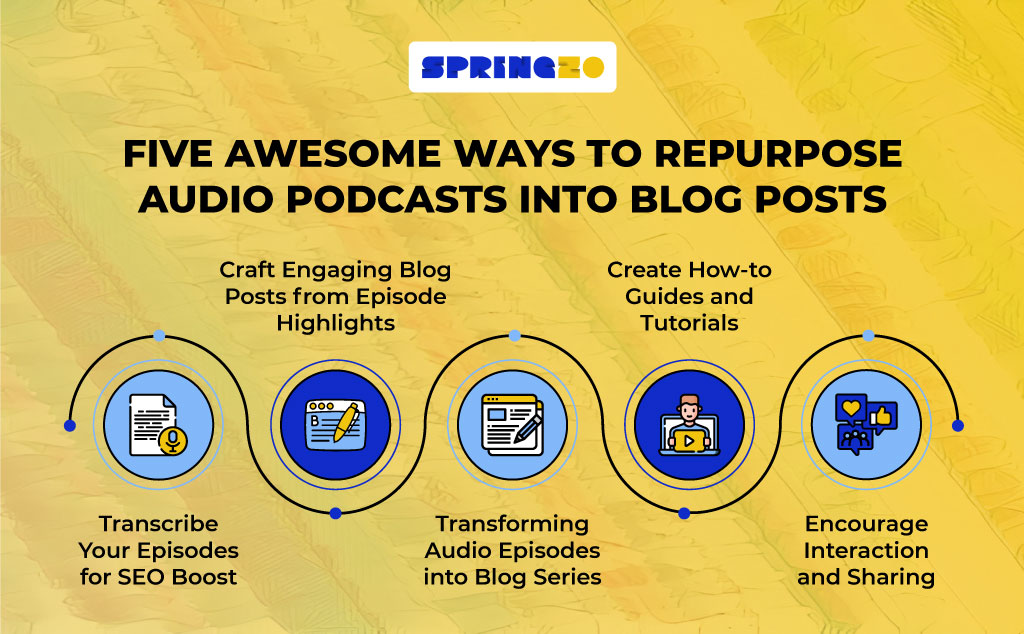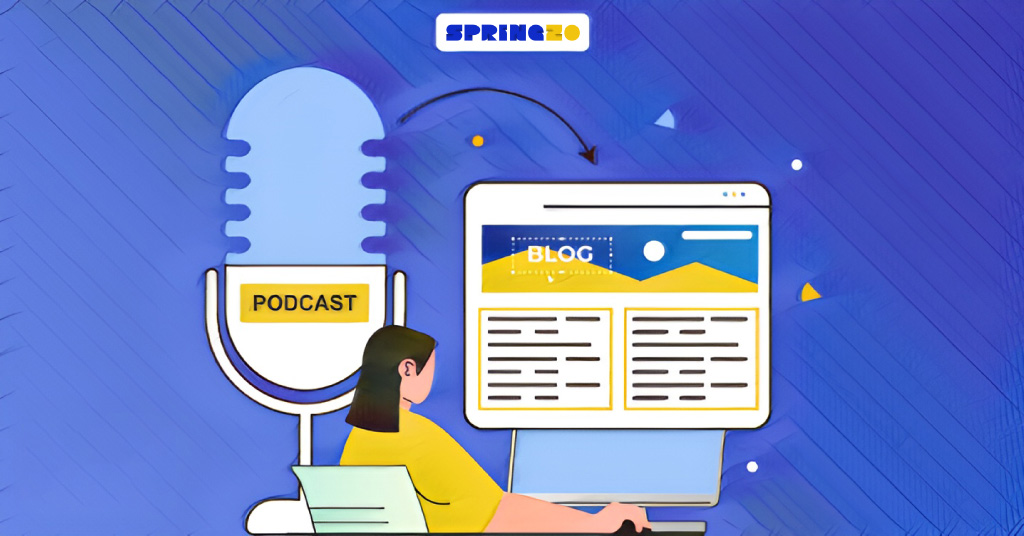There is little doubt that post-pandemic podcasts are storytelling game-changers for brands, content marketers, and entrepreneurs alike. But here’s the kicker: Your podcast’s power often extends beyond audio. This can be an opportunity to repurpose podcast content into captivating, value-added, evergreen blog posts to amplify your brand message.
To be specific:
A whopping 46% of marketers swear by repurposing content over creating new. It expands your audience, boosts search engine visibility, and entices diverse content enthusiasts.
Turning spoken gems into written gold spreads your message and skyrockets brand discovery. So, any forward-thinking content marketers should consider blending podcasts and blogs for a knockout content strategy!
Dive into this comprehensive guide to discover the creative ways to repurpose podcast content into engaging blog posts and maximizing your efforts.
Benefits of Repurposing Podcast Content into a Blog
When you repurpose podcast content into blog posts, it can provide multiple benefits. Let’s explore each aspect to understand the advantages of this transformation:
1. Expanding Reach
Turning podcast content into blogs broadens your audience, potentially boosting search rankings by 434%. While podcasts suit listeners, blogs appeal to readers, meeting diverse learning preferences and expanding your audience effectively.
2. SEO Boost
After you repurpose podcast content into blog posts, it can promote your SEO efforts and increase visibility across channels. Text content happens to be more search-engine-friendly, making it easier for people to discover your material. Do not forget to update the keywords to garner the most views.
3. Advantage of Permanence
Extend the shelf life of your podcasts by repurposing them into blogs. Evergreen blogs and materials ensure that user-friendly and value-added insights endure longer, remaining accessible even after the original episode.
4. Enhanced User Experience
By providing a blog version, you meet diverse preferences, improving the overall user experience for those who prefer scanning written content over listening to a full podcast episode.
Five Awesome Ways to Repurpose Audio Podcasts into Blog Posts:

Now that we know that to repurpose podcast content into blogs can be fantastic for reaching more audiences and broadening the scope of conversion, here are 5 tried-and-tested methods to turn a podcast episode into a blog post. Let’s dive in!
1. Transcribe Your Episodes for Heightened Visibility
Transcribing podcast episodes serves a dual purpose by making content accessible to a wider audience. For example, those who prefer text content consumption or people with disabilities like hearing impairments can connect to your content. On the other hand, it also promotes your SEO efforts, resulting in high-visibility spots in Search Engine Result Pages (SERPs).
Since search engines can’t crawl audio, transcriptions and transcription-based blog posts create a searchable textual asset, drawing more organic traffic to your website.
Tip: Automated Transcription Tools
If you want to simplify transcribing your podcasts, try using tools like Otter.ai or Rev.com. They do the heavy lifting by quickly turning your episodes into written text. After that, you can go through the text, add keywords, and make any necessary tweaks to make sure it is palatable to the audience.
2. Craft Engaging Blog Posts from Episode Highlights
Another way to repurpose podcast content is to condense the key takeaways and most engaging moments from your podcast episodes into highlight reel blog posts. This lets your audience quickly grasp the main points without committing to the full audio experience.
Tip: Create Visuals and Infographics
Spruce up your blog’s main points by adding cool visuals and infographics! They don’t just make your posts more eye-catching but also boost engagement. Try user-friendly tools like Canva as well.
3. Transforming Audio Episodes into Blog Series
Consider transforming your podcast episodes into a blog series. Take a deep dive into specific topics and aspects discussed in your episodes and expand on them in the blog posts with additional inputs.
Tip: Interlink Your Blog Posts
When crafting a blog series, it’s crucial to interlink your posts. This practice not only enhances user experience by providing seamless navigation but also positively impacts your website’s search engine optimization (SEO). Interlinked content is perceived by search engines as more cohesive and relevant, thereby elevating your site’s authority and visibility.
4. Create How-to Guides and Tutorials
Extract actionable insights from your podcast episodes and transform them into how-to guides or tutorials. If your podcast discusses industry-specific tips or strategies, breaking them down into step-by-step guides can provide immense value to your audience.
Tip: Include Practical Examples
Enhance the effectiveness of your how-to guides by incorporating real-life examples. By sharing practical stories or case studies that illustrate your points, you provide tangible context that helps readers understand and apply your insights.
This approach makes your content more relatable and engaging, increasing the likelihood that readers will actively implement your strategies and tips in their own contexts.
5. Encourage Interaction and Sharing
Include a clear call-to-action (CTA) within your blog post. Encourage readers to share their thoughts, opinions, or experiences related to the podcast topic. Foster a sense of community by inviting comments and discussions, turning your blog into an interactive platform.
Tip: Foster Community Engagement Through Social Media
Try sharing bite-sized informative pieces on social media like Twitter, Instagram, or LinkedIn. Get your readers talking, throw in some questions, and dive into conversations with different online groups. It’s a surefire way to spread your influence far and wide!
Bottom Line
When you repurpose podcast content into blogs, it can become more impactful, expanding the reach and making content more accessible. This approach strengthens your brand and suits different preferences, optimizing impact.
To reach a wider audience, see both mediums as a smart investment. Creating content takes time, though. Teaming up with a content marketing agency makes the process smoother, ensuring strategic growth.
Springzo can repurpose podcast content to captivate your target audiences and skyrocket your reach. We’re your partners from idea to execution, crafting standout content. Our value-driven approach can ensure top-notch content that slices through chaos. Let us redefine your content galore by seamlessly turning your podcasts into a captivating blog series.
Ready to level up your content marketing? Start a conversation today!
FAQs
Q1: Is transcribing every podcast episode necessary?
Transcribing every episode is not mandatory, but it can significantly enhance your content’s accessibility and SEO. Consider transcribing key episodes or those with valuable information to maximize the benefits.
Q2: Can I repurpose podcast content into other formats besides blogs?
Absolutely! Podcast content can be repurposed into various formats, including ebooks, social media posts, and video content. The key is to adapt the content to suit the preferences of different audiences on different platforms.
Q3: Are there copyright concerns when repurposing podcast content?
Ensure you have the rights to your podcast content before repurposing. If you use third-party content, adhere to copyright laws and obtain necessary permissions. Focus on adding value and transforming content rather than simply duplicating it.
Q4: Should I repurpose all types of podcast episodes?
While not every episode may be suitable for repurposing, focus on those with evergreen or valuable content. Interviews, expert insights, and in-depth discussions are prime candidates for repurposing into various blog formats.
Q5: How can I measure the success of repurposed content?
Track metrics such as website traffic, engagement, and social shares for your repurposed content. Use tools like Google Analytics and social media analytics to gauge the impact and adjust your strategy accordingly.
